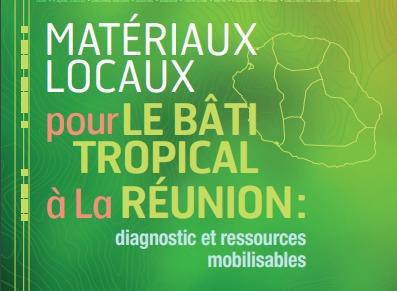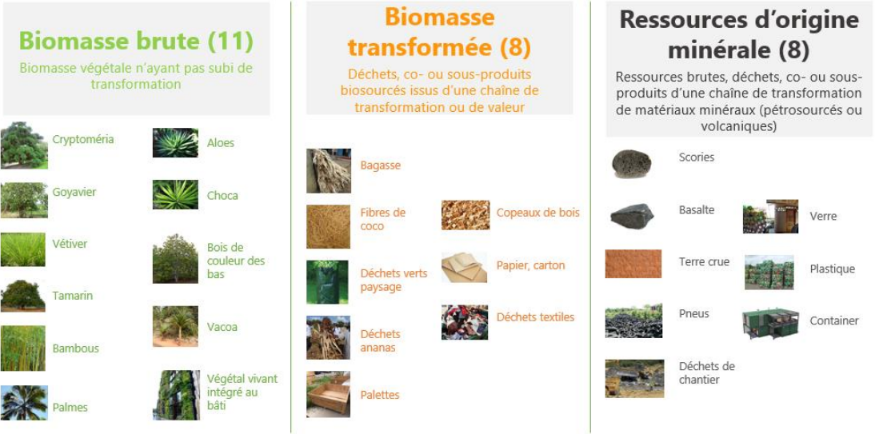#7 Development strategy for the "tropical built" sector

With the "BIOREV Tropics" project, Nomadeis, BioBuild Concept and the Laboratoire d'Écologie Urbaine de La Réunion, have studied the particularities of insularity and the difficult problem of developing local sectors. Here is a summary of this document, which is one of the first steps towards full recognition of the specificities of construction in French tropical areas. See the study.
The local context
Reunion Island is part of a strong desire to integrate sustainable development into all the decisive points of its social policy, its environment and its economy. In this regard, sustainable construction is defined by a good thermal design of the building as well as a choice of local materials, with low "grey energy", thermally efficient, and in accordance with the tropical climatic conditions of Reunion Island.
Until now, despite a real determination to develop certain Reunionese resources, most of the materials used in construction remain imported: which has economic, environmental and social consequences. They are more expensive to buy in Reunion Island than in metropolitan France. These large expenses made by construction companies for the acquisition of materials produced abroad correspond to a "lost" value for the island. However, this value could remain in place provided that the local materials sectors are sufficiently structured and developed to meet demand. The use of local materials therefore appears to be a strategy to stimulate employment and create added value that is difficult to relocate.
In France, according to the Fédération Française du Bâtiment (FFB), 44% of the energy consumed is attributable to the construction sector. The extraction, import and then implementation of imported building materials are activities with a high environmental impact that add to the carbon footprint of the Reunion Island construction sector, since it is a net importer of materials, most of which are themselves high carbon footprint materials. Take concrete, for example: the manufacture of cement is responsible for nearly half of the construction sector's greenhouse gas emissions.
In a tropical context that is both hot and humid, the issue of thermal comfort in buildings is essential for the well-being of the inhabitants. Reunion Island has a wide variety of topography (coastline, medium mountain, high mountain), which means that the climatic zoning is very strong. The proper adaptation of the building to natural constraints (although essential) is therefore more difficult, since it is not possible to replicate a standard model that would be suitable for all building sites. The implementation of bioclimatic building principles aims to facilitate the achievement of thermal comfort in a passive way (non-energy consuming and non-emitting of greenhouse gases) by integrating the natural data of the chosen construction site. Consequently, the adaptability of the construction to the natural site is a condition for the well-being of the inhabitants, which can only be ensured by the use of tropical buildings without a significant impact on the environment and heritage.
In general, the composition, manufacture, use and end-of-life of conventional products can be sources of potential negative impacts on the environment and human health, and a movement towards more sustainable construction from this point of view should therefore be initiated. Reducing the volume of waste produced on the island and non-recycled is therefore a major social challenge. For this reason, the BioRev'Tropics project has also given a high priority to materials made from recycled waste.
Organization of the BIOREV Tropics project
Winner of a call for projects launched by the DIRECCTE La Réunion, the BioRev'Tropics project - The use of local materials for construction in tropical environments - is based on field observation, the listening and the experience of actors involved in the development of the tropical built sector to identify development potential and to facilitate the identification and financing of actions aimed at: "strengthen the use of local building materials and maximize the socio-economic benefits for the territory, particularly in terms of employment and skills".
The project was carried out in three main phases:
• A preliminary phase of a quick diagnosis of the sectors (existing and potential sectors) of local materials based on a resource approach and then compilation of the action plans identified by the collective.
• An intermediate phase of a telephone survey of construction companies to qualify and quantify the effective use of local materials in Reunion Island (see the survey analysis report and the report compiling the raw results).
• A downstream phase of compilation of the elements: drafting of a draft roadmap integrating the action plan, analysis of the survey results and a final project report.
Feedback from the survey
This survey, carried out among 2400 craftsmen spread evenly over the territory, revealed the strong sensitivity of companies responding to the local nature of the materials they use as well as a general curiosity about these materials. The professionals interviewed consider themselves to be actors in the energy and ecological transition, and are therefore sensitive to the environmental impact of the materials they use... However, the majority of respondents state that they are not familiar with the principles of tropical building construction, of which bioclimatic building is a part. Increased use of these principles is therefore a major challenge in limiting the environmental impact of the building sector in Reunion Island.
The integration of vegetation into buildings is approved by a large majority of craftsmen, who consider that living plants should be more integrated into Reunion Island buildings for reasons of comfort, energy performance, aesthetics and the protection of heritage and biodiversity.
The use of local materials remains a minority compared to the use of imported materials. Only 15% of respondents believe that more than 50% of the materials they use are of local origin, and this is due to two reasons: availability and price. In the case of some materials where there is already a supply chain, such as wood, some craftsmen refer to quantities that are too small and a supply chain that is not sufficiently developed; in the case of other materials (plaster, cement, scrap metal, etc.), the supply chain does not even exist, so import becomes compulsory.
In addition to the financial argument, the certification of the material appears to be the third most important criteria in the choice of materials for craftsmen. Indeed, increasingly strict safety rules are required, particularly in construction sites where the customers are public actors, which concern 37% of the craftsmen surveyed. They also point out that the application of European standards in a territory whose characteristics are very different from those of the metropolitan area constitutes a major obstacle to the development of the use of local materials. Respondents express a strong interest in the use of local materials, provided that these materials are available and accessible....
There is general agreement on the importance of protecting Reunion Island's heritage and know-how, as well as transmitting local know-how relating to construction. The most frequent criticism is: "There are many architects here who are trained in metropolitan France and are building as in metropolitan France, without taking into account the climate and topology of Reunion Island. »
Plans d’actions
The applications of local materials targeted by the project to be used in construction are as follows:
- Vegetal concretes and light concretes (whose biosourced aggregates are for example pallets, bagasse, slag, etc.) ;
- Insulation (e. g. made from paper, fibre, bulk, basalt, etc.);
- Structural elements (manufactured for example from processed biomass such as bamboo, cryptomeria, etc.);
- Roofing and cladding elements (manufactured for example from processed biomass such as vetiver, palms, tamarind, etc.) ;
- Glues, paint (produced from processed biomass such as choca, algae, etc.);
- Shading and natural cooling elements (which constitute living plant masses) that can be divided into three types of applications: green roofs, green facades and green walls

A) Research and development of innovative materials and regulatory principles
Various research and development projects aim to design materials from local resources for use in construction. Local materials remain, on a technical level, a field to be investigated: innovation allows the discovery of new solutions whose purpose is to promote local resources for the manufacture of materials with a low environmental impact and whose technical characteristics remain similar to those of conventional materials.
- The economic competitiveness of local materials can only be effective in the long term, when the sectors are structured: it is therefore important, from now on, to raise awareness among construction stakeholders and the general public of the positive externalities of these materials. It is therefore necessary to formalize the various user feedback by drawing up a charter of good practices and developing awareness-raising materials in order to disseminate this knowledge.
- Development of vegetal concretes from local resources. Reunion Island is rich in local resources that can be used for construction. Innovation must therefore focus on materials that can be designed from these local resources and more generally on resources available both locally and throughout the humid tropical zone, so that developers of these materials can export and replicate their technico-economic model to other areas of the planet.
- Study of the characteristics relating to the insulation of composite materials and support for industrial-scale transition: Composite materials (integrating both biosourced and conventional materials) are a good compromise between the accessibility of the raw material and the use of local materials.
- Innovation in regulatory matters, within a context of energy and ecological transition, plays a leading role in improving the energy performance of buildings. More experimentally, innovation can also be applied to the definition of new conceptual frameworks and new approaches to construction itself. Metropolitan standards are often inadequate and there is a need to create specific standards. The PLU of the Cœur de Ville de la Possession and its eco-neighbourhood (see case study) is for example an illustration of the success of political voluntarism in favour of an increased use of bioclimatic building.
- Structuring and development of a local bamboo sector: Easy to cultivate and resistant, it only takes one year to grow, without fertilizers or other phytosanitary products, and three years to reach maturity. This makes it possible to operate it quickly, after four years. In addition, by capturing more CO2 than trees, bamboo releases more oxygen. It is already used in many countries near Reunion Island, and more generally throughout the humid tropical zone.
B) Tropical construction and evolution of behaviour and uses: The use of tropical construction techniques to achieve hygrothermal comfort without carbon impact
In the humid tropical zone, the humidity level of the air is a key factor that must be taken into account in order to facilitate the achievement of the user's feeling of comfort.
Air conditioning is a quick way to cool a home. Nevertheless, this solution is not sustainable, it should be highlighted that its overall heat balance is positive and causes cities to warm up. Therefore, the use of passive cooling systems integrated into the building according to the principles of tropical building should be encouraged.
- Vegetation Plan for Urban Spaces and Rural Areas: Urban vegetation contributes to the local mitigation of urban heat islands mainly through tree shade, which reduces ground and building surface temperatures. In addition, water lost by plants through evapotranspiration and transferred from the soil to the air cools it down.
- The massification of renovation: This is a way to fight against fuel poverty and the drying effect caused by an unsuitable and inefficient building. The application of tropical building principles in the renovation of existing buildings appears to be a way of improving the energy performance of Reunion Island's housing stock.
C)Adaptations and impacts of the use of tropical building on jobs, skills and training
Despite the absence of certain professions and skills, the offer in terms of initial and continuing training in tropical building is rich and the network of training actors is dense. The training offered is still too punctual and insufficiently structured
- The offer of initial and continuing training is rich but still insufficiently integrated into a global approach around tropical buildings. It could therefore be interesting to enrich the "tropical built MOOC" by including a section on the characteristics and implementation of local materials. The prospective development of training needs is a key issue in the theme of employment and skills related to tropical building and the use of local materials.
- Enhancing the value of occupations related to tropical building is also an important objective: The restoration of the image of manual occupations, and in particular manual occupations related to tropical building, is a major challenge. Communication actions must be undertaken in order to rehabilitate these trades, in particular by recalling the strong cultural link between them and the knowledge and techniques of the past.
The editors of Construction21 would like to thank Jérôme VUILLEMIN, then a researcher at the Centre d'Innovation et de Recherche de Bâti Tropical (CIRBAT), for his invaluable help in producing this synthesis.

Consult the previous article:: #6 Construction of local building materials sectors: a social as well as an economic challenge





